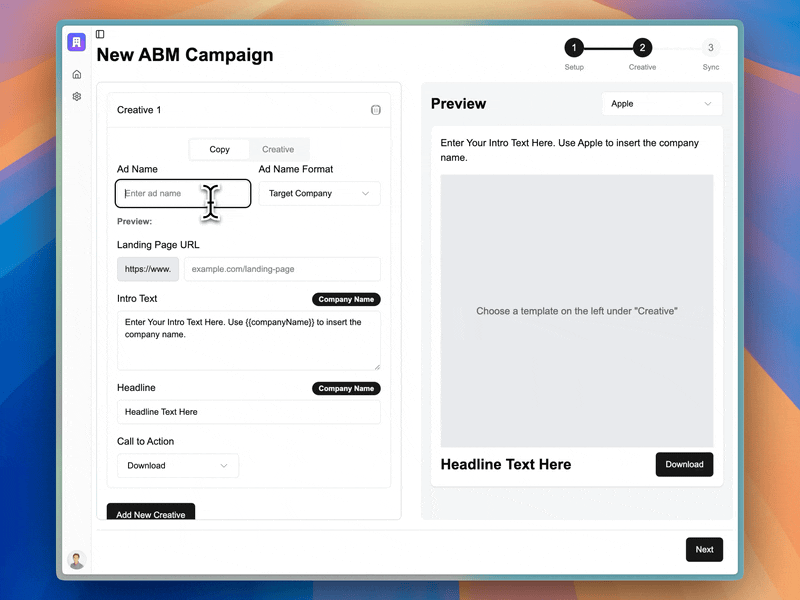In the wake of sweeping tariff changes implemented in April 2025, digital marketers are challenges to maintain performance while protecting margins. With a 10% baseline tariff now applied to all imported goods and China-specific rates soaring to 125%, businesses across industries are feeling the squeeze. According to a recent Interactive Advertising Bureau survey, 94% of advertisers are concerned about how these tariffs will impact their marketing budgets. But economic disruption also creates opportunity for agile marketers who can adapt quickly and strategically.
Key Highlights
- Strategic Reallocation: Shift budget from broad campaigns to high-margin products less affected by tariffs
- Data-Driven Decisions: Use analytics to identify which channels deliver the best ROI during economic uncertainty
- Efficiency Focus: Prioritize conversion rate optimization over acquisition to maximize existing traffic value
- Content Investment: Double down on owned media channels that deliver 3x the leads per dollar compared to paid search
- Contrarian Opportunity: Consider maintaining or increasing spend in select channels while competitors retreat
TABLE OF CONTENTS:
Understanding the Tariff Impact on Digital Marketing
The April 2025 tariff implementation has created a complex landscape for marketers. Beyond the 10% baseline tariff on all imports, specific industries face varying levels of impact. According to retail industry analyst Bryan Gildenberg, “Categories are all over the map – toys and games are the highest tariffed and highest import percent category by far,” noting that discretionary purchases are particularly vulnerable to consumer hesitation.
This economic pressure is already reshaping digital marketing budgets. The IAB survey reveals that social media (41%), gaming (24%), and linear TV (24%) are experiencing the most significant cuts, while Connected TV appears more insulated with only 12% of advertisers planning reductions.
For many businesses, the immediate response has been defensive. According to RSM’s research, advertisers are implementing several strategies to address financial constraints:
- Reducing overall ad spend (45%)
- Increasing focus on performance-based campaigns (35%)
- Shifting to digital channels with better measurement (29%)
- Adjusting campaign messaging (28%)
- Negotiating more flexibility (21%)
However, these challenges also present strategic opportunities for marketers willing to take a more nuanced approach.
Immediate Response Strategies (First 30 Days)
The first month after tariff implementation is critical for stabilizing your marketing performance. Begin with a comprehensive SKU-level tariff exposure analysis to identify which products in your portfolio are most vulnerable to margin compression.
“Audit SKU-level tariff exposure (10–34% increases), starting with top-velocity items,” advises e-commerce recruitment specialist Harry Joiner, who recommends “re-forecasting post-tariff contribution margin by channel.” This data-driven approach allows you to make informed decisions about where to maintain, increase, or reduce marketing investment.
While many competitors may instinctively slash budgets across the board, consider holding steady on your highest-performing channels. As digital marketing expert Dana Forman notes, “If others pull back, you may gain share at a lower CPC.” This counter-cyclical approach requires courage but can yield significant market share gains when competitors retreat.
For your paid search and social campaigns, prepare for auction volatility by adjusting your ROAS targets to account for increased costs. This might mean accepting temporarily lower returns while the market stabilizes, or shifting budget to products with healthier margins.
Budget Reallocation Tactics
Rather than implementing across-the-board cuts, successful marketers are taking a surgical approach to budget reallocation. The key is shifting from growth-focused to efficiency-focused advertising strategies.
Reserve your advertising inventory “for known winners and margin accretive products” while deprioritizing broad brand campaigns during this period of adjustment, suggests Joiner. This reprioritization ensures that your limited marketing dollars are working hardest where they can generate the most efficient returns.
Consider implementing a flexible budget model that allows for quick pivots based on performance data. Set aside a portion of your budget (10-15%) as a “response fund” that can be deployed opportunistically when you identify channels or products performing above expectations despite the challenging environment.
For products heavily impacted by tariffs, evaluate whether marketing spend can be temporarily reduced or redirected to complementary offerings with healthier margins. This doesn’t mean abandoning these products entirely, but rather adjusting their prominence in your marketing mix until pricing strategies can be recalibrated.
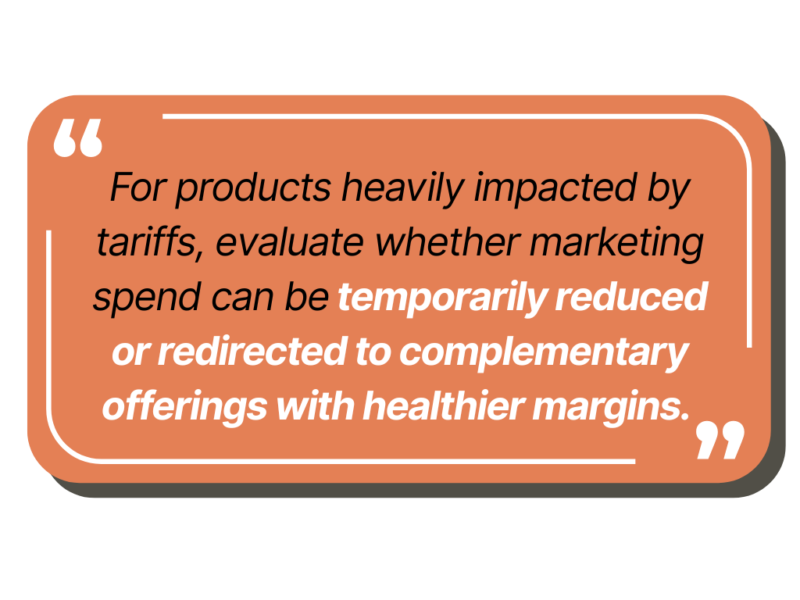
Channel Optimization Strategies
The tariff environment creates an opportunity to reevaluate your channel mix with fresh eyes. According to RSM’s research, 29% of advertisers are shifting to digital channels with better measurement capabilities—a smart move when every marketing dollar must demonstrate clear returns.
If your business has relied primarily on Google Ads and Facebook for paid lead generation, now is the time to explore alternatives. Connected TV advertising is showing resilience in this environment, with only 12% of advertisers planning cuts compared to 41% for social media. This precision-targeting channel allows for more granular audience segmentation and measurable outcomes.
For B2B marketers, platforms like LinkedIn offer highly targeted reach, while industry-specific platforms can provide access to niche audiences at lower costs. Tools like Karrot.ai can help transform your LinkedIn ads with 1-1 personalized messaging that converts more effectively—exactly what’s needed when budgets are under pressure.
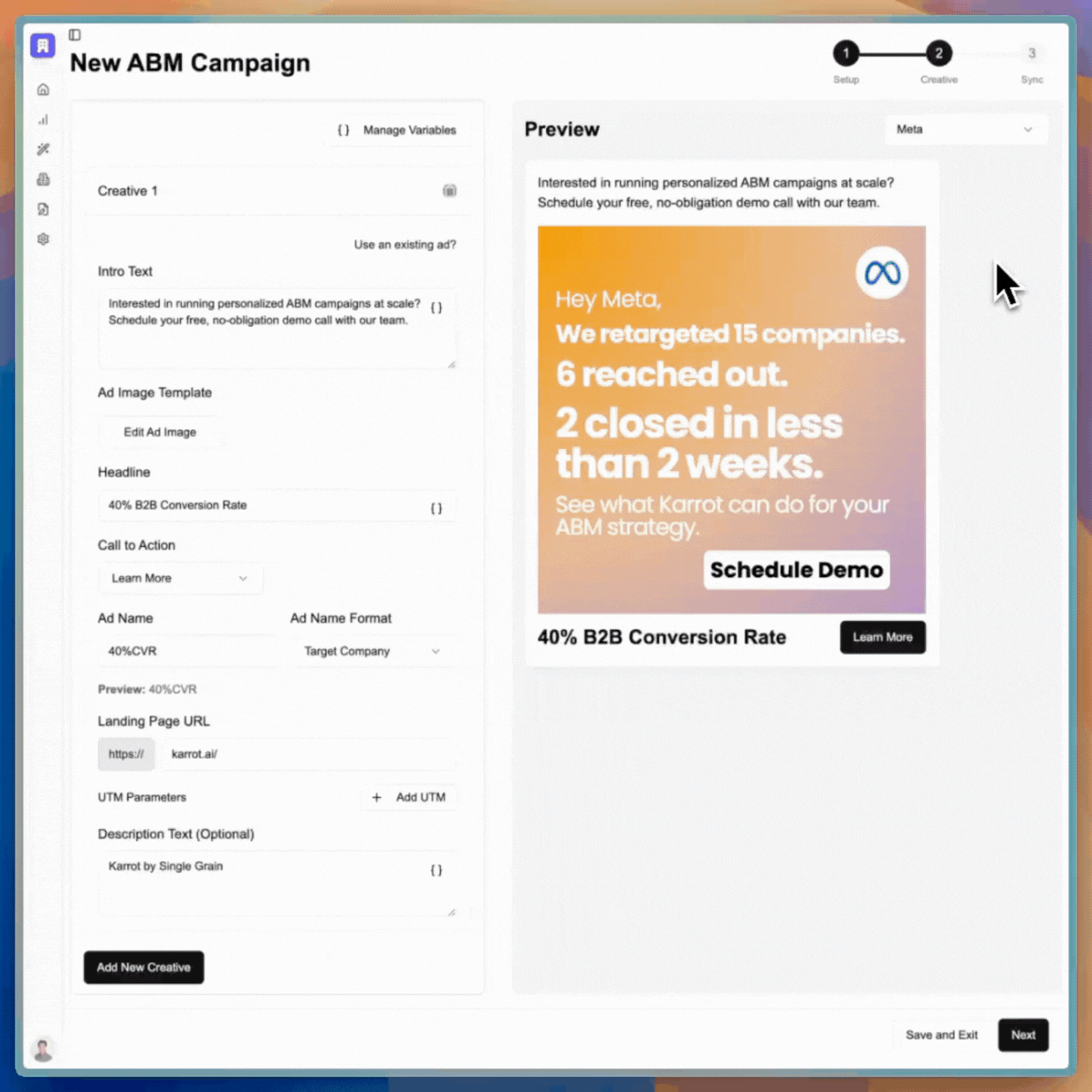
Watch for CPC drops as competitors pull back spending, particularly in the wake of the de minimis rule changes affecting Chinese sellers. As Seer Interactive notes, “On May 2, 2025, the U.S. is expected to end the De Minimis exemption for sub-$800 shipments from China. This could hit DTC giants like Shein and Temu—major players in Google and Meta’s ad auctions.” These shifts may create unexpected opportunities in previously competitive keyword auctions.
Content and Messaging Pivots
Your marketing message needs to evolve in response to tariff-driven price changes. For products manufactured domestically, test “Made in the USA” messaging to attract consumers seeking to avoid tariff-impacted goods. This positioning can transform a previously neutral product attribute into a compelling selling point.
Transparency about price changes is essential. Create educational content that addresses consumer concerns directly, such as guides on “How to Plan Purchases with 2025 Tariffs in Mind.” Add FAQ schema and messaging banners to relevant product pages explaining current conditions, which can improve both user experience and SEO performance.
For premium products facing price increases, develop messaging that reinforces value over cost. As Bryan Gildenberg notes, most high-tariff categories are discretionary purchases where “price point trade down or deferring purchase are options for a sticker-shocked shopper.” Your content should address this directly by emphasizing durability, long-term value, and quality differentiators that justify the premium.
Leveraging Owned and Earned Media
As paid media costs fluctuate and margins tighten, owned and earned channels become increasingly valuable. Content marketing consistently delivers three times more leads per dollar than paid search, making it particularly effective during periods of budget constraints.
Prioritize growing and activating your email and SMS lists, which provide direct communication channels unaffected by advertising auction dynamics. These owned audiences become critical assets during economic uncertainty, allowing you to maintain customer relationships without ongoing acquisition costs.
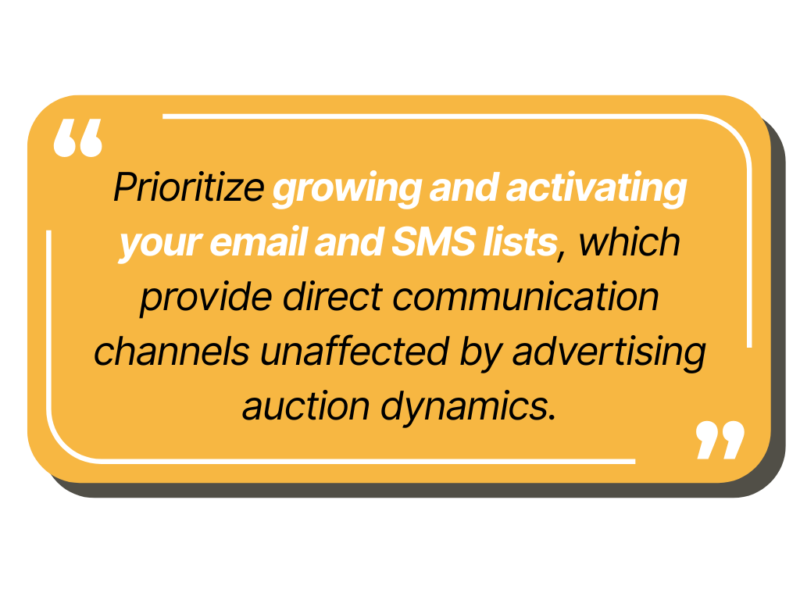
Double down on SEO and evergreen content creation that will continue generating traffic long after publication. While competitors focus on short-term performance, investing in organic visibility can create sustainable competitive advantages that persist beyond the current tariff situation.
Consider leveraging influencers for cost-effective creative development, especially as production budgets tighten. This approach not only reduces content creation costs but also taps into established audiences with high levels of trust—a valuable commodity when consumers are becoming more selective about their purchases.
Customer Retention Focus
During economic uncertainty, customer retention becomes even more valuable than acquisition. According to marketing strategist Katharine McKee: “To weather downturns you need to find a way to make back lost profits,” and while “cuts are easier than growth, they represent a slippery slope.”
Create specific segments for customers browsing high-priced or tariff-affected products, and develop retargeting strategies that address their potential hesitation. Set up abandoned cart recovery workflows with messaging that acknowledges price concerns while reinforcing your value proposition.
Implement loyalty programs that incentivize repeat purchases despite price increases. Consider offering tiered benefits that reward continued engagement, or bundle complementary products to maintain average order values even as consumers become more price-sensitive.
As Jason Landro, co-CEO of digital marketing agency Nectar, advises: “Focus on improving your conversion rates. Attempt to increase click-through rates.” These optimization efforts can help maintain performance even with reduced top-of-funnel investment.
The Contrarian Approach: Strategic Investment
While defensive strategies dominate the current landscape, some experts advocate for a more aggressive approach. “Now is the time to grow your market share while competitors are scared,” argues Landro, suggesting brands “don’t cut back on ad spend” but instead “get hyper efficient without taking steps backwards.”
This contrarian perspective recognizes that market share gains made during economic disruption can persist long after conditions normalize. By maintaining visibility while competitors retreat, you position your brand for accelerated growth when consumer spending rebounds.
McKee offers similar advice: “Marketing is the easiest and the first to go but be strategic. Brand building now will make lower funnel easier in a few months, so if you need to make cuts here do it on the moonshots.” This balanced approach preserves core marketing functions while eliminating experimental initiatives with uncertain returns.
The resilience of Chinese sellers despite steep tariffs offers an instructive example. According to Joe Zhang, who recently met with Chinese Amazon sellers, these businesses “are pursuing branding more aggressively” and “may challenge some U.S. local brands using more aggressive cost strategies.” Their experience managing similar cost pressures during the extreme shipping costs of 2021 has prepared them to weather the current situation—a reminder that adaptability often matters more than absolute cost position.
Implementation Roadmap and Timeline
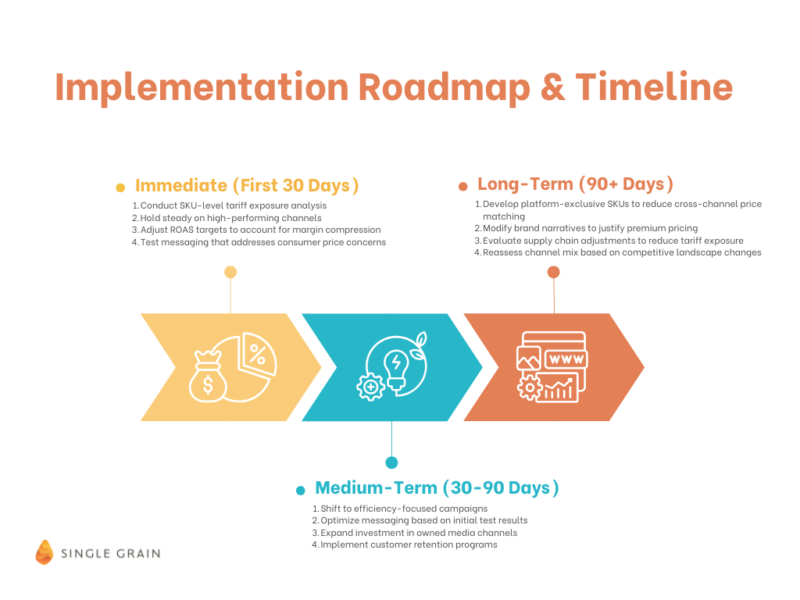
Implementing these strategies requires a phased approach:
Immediate (First 30 Days):
- Conduct SKU-level tariff exposure analysis
- Hold steady on high-performing channels
- Adjust ROAS targets to account for margin compression
- Test messaging that addresses consumer price concerns
Medium-Term (30-90 Days):
- Shift to efficiency-focused campaigns
- Optimize messaging based on initial test results
- Expand investment in owned media channels
- Implement customer retention programs
Long-Term (90+ Days):
- Develop platform-exclusive SKUs to reduce cross-channel price matching
- Modify brand narratives to justify premium pricing
- Evaluate supply chain adjustments to reduce tariff exposure
- Reassess channel mix based on competitive landscape changes
Looking Forward
While tariffs create undeniable challenges for digital marketers, they also accelerate trends that were already reshaping the industry: the shift toward efficiency, the growing importance of owned media, and the value of data-driven decision making.
By approaching this disruption strategically rather than reactively, you can protect your marketing performance while positioning your brand for future growth. The marketers who will emerge strongest from this period are those who view efficiency not as a temporary response to budget constraints, but as a fundamental principle that drives every aspect of their digital strategy.
For personalized advertising that maximizes ROI during these challenging economic periods, tools like Karrot.ai can help transform your LinkedIn ads with 1-1 personalized messaging that actually converts. By delivering individualized messages without sacrificing scale, Karrot helps you make the most of every advertising dollar—exactly what’s needed in today’s tariff-impacted marketing landscape.




